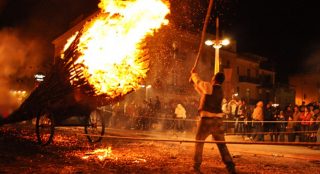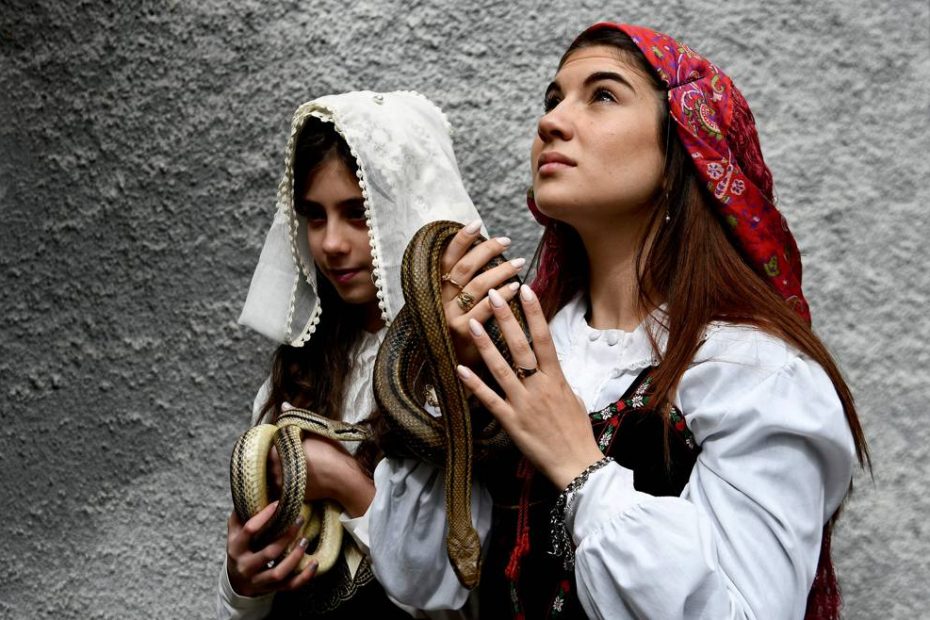Italy is an extremely religious country, for better or worse. And it stands to reason – the Vatican, center of the Catholic faith, is in the hearth of our capital city, Rome.
However, Italian history is way older than Catholicism, and so are our traditions. And these traditions are hard to die. So when Christianity became the main religion in the peninsula, instead of erasing the ancient gods and the pagan magic, it twisted them in order to accomodate them in its doctrine. As a result, Italian religious traditions are a mixture of paganism and Catholicism, where saints are worshipped like the gods of old, and blood sacrifices are made. Let me show you some examples:
Festa dei Serpari
The Festival of the Snakecatchers (Festa dei Serpari) is a traditional festival in Cocullo, in the Abruzzo region. During the festival, people celebrate Saint Domenico by parading around the city a statue of the saint covered in living snakes, previously caught in the fields surrounding the town by expert snake catchers. Don’t worry! When the festival is over, the snakes are freed in the places where they have been caught, unharmed albeit a little confused.
The celebration is way older than Saint Domenico, however. A similar festival was celebrated by the Marsi, an ancient italic people, in order to worship the goddess Angitia, a ctonic deity associated with snake charmers. According to the legend, she was sister to Circe and Medea, two powerful sorceress. Angitia is thought to live near the Fucine lake, and her magic is particularly strong against snake bites – hence the association with snake catchers.
The Marsi are long gone, and Angitia long dead, but the festival of the snake catchers lives on – it only celebrates a different ‘god’.

The statue of Saint Domenico covered in sankes
Processione delle Fracchie
The Procession of the Fracchie is a peculiar Easter celebration that takes place in the town of San Marco in Lamis, in Apulia. During the celebration, giant torches 5 to 6 meters long – the fracchie – are pulled in procession by two or more people. The origin of the fracchie is unknown. Some think of this as a fairly modern tradition, dating back to 1800. Others, however, place the origin of this peculiar and quite breathtaking procession in ancient times. And given how Easter itself was first a pagan celebration, it’s not crazy to think that the fracchie were too something borrowed, or rediscovered during the centuries, from pagan traditions.

A flaming fracchia
Vattienti di Nocera
CW: Blood, self-harm
This is a pretty hardcore Italian tradition. Another Easter rite celebrated in Nocera Terinese, in Calabria, revolves around peculiar figures: the vattienti. These are men that walk the city in procession while practicing self-flagellation by using a special tool: the rosa (rose), a piece of cork into which are embedded sharp shards of glass – thirteen, like Christ and the apostles, Judas the longest and sharpest of all. The vattiente uses the rosa to beat his naked tights and calves, while with the cardo (thistle) – a sponge – he wipes away his blood.
Despite its Christian interpretation, the rite of the vattienti is extremely ancient. Some people think its origins can be traced back to a similar rite performed in Asia Minor, to celebrate the god Attis. This is not hard to believe, as Attis is consort and son of the goddess Cibele, an Anatolian goddess who was brought to Italy back in Etruscan times. Not to mention the fact that all of southern Italy was under Greek domination in ancient times. Some sources think the Greek themselves were the ones who brought the cult of Attis and Cibele in Calabria, along with the self-flagellation rites associated with them.

Instead of a gruesome picture of the vattienti, here a statue of the god Attis
Carnevale
The Carnevale is perhaps one of the most popular italian celebrations – who doesn’t know about the beautiful Carnevale of Venice? Or the stunning Carnevale of Viareggio, with its magnificent floats? The celebration, nowadays, is associated with the Lent – it’s the last grand celebration before a period of fasting and sobriety. However, the roots of this celebration are to be found in ancient rites.
The Carnevale, with its floats and mask, reminds of the grand celebrations for the god Dyonisius, or the Roman Saturnalia, a festival during which beatiful floats would parade in the city and the differences of social classes would fall, just like modern Carnevale. However, the tradition of Carnevale may be even more ancient. It roots may be as well as 4000 thousands years old, to be sought in fertility cults associated with nature and cultivation.

One mesmerizing float from the Carnevale di Viareggio
These are but a few examples from the incredibly rich list of Italian ‘christian’ traditions that find their roots into ancient paganism. Omnia mutantur, nihil interit – everything changes, nothing dies. The rites may have changed face, they may have changed meaning, but they are still the same, carried on from century to century.
And the ancient gods with them.
